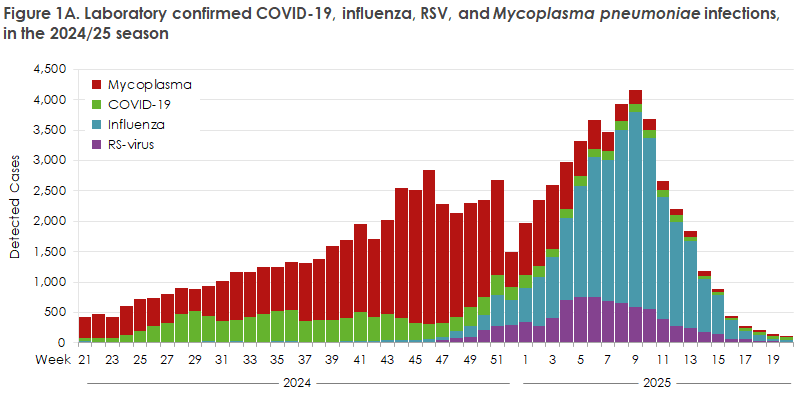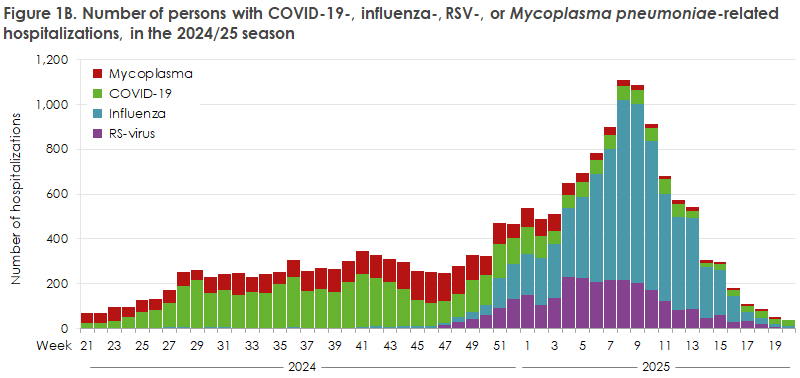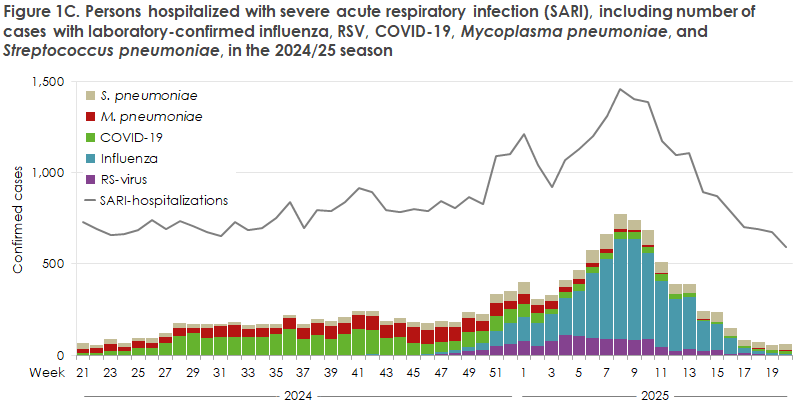No 22 - 2025
Integrated surveillance of respiratory infections in 2024/25 – consolidated report
Summary of the respiratory season 2024/25
In the 2024/25 season, the overall surveillance of respiratory infections included not only the three well-known viruses – influenza, RSV, and SARS-CoV-2 – but also the bacterial infection Mycoplasma pneumoniae. This is due to the fact that M. pneumoniae continued to circulate at a high level in the 2024/25 season.
Already during the summer and autumn of 2024, an elevated incidence of both SARS-CoV-2 and M. pneumoniae was observed. At the end of November, the number of cases with influenza and RSV also began to rise – a pattern that followed the seasonal course known from before the COVID-19 pandemic. This led to a peak in the burden of infections, hospitalizations, and SARI hospitalizations (hospitalizations with severe respiratory infection) in February 2025, figure 1.
- Influenza: The influenza season was intense, where from the beginning of 2025 onwards, the influenza virus was the most dominant respiratory infection – both in terms of number of infected and hospitalized patients. For several weeks, both the number of cases and hospitalizations were at a high level.
- Covid-19: The season was milder than previous periods, as the number of cases and hospitalizations remained at a medium level throughout 2024, and then fell to a low level in 2025.
- RSV: The number of RSV cases and related hospitalizations reached a high level in some weeks. Overall, the RSV season was milder compared to previous post-pandemic seasons.
- Mycoplasma pneumoniae: The number of infections remained at an elevated level in 2024 and the beginning of 2025. Especially in summer and autumn 2024, it constituted a significant part of the disease burden with over 60% of total respiratory infections and more than 30% of hospitalizations.
- Vaccination coverage: Influenza and COVID-19 vaccination coverage was over 75% among the older portion of the population aged 65 years and above.
Figure 1 shows which viruses and bacteria contribute most to the overall burden of respiratory infections as well as the overall burden on the healthcare system measured by hospitalizations and hospitalizations with severe respiratory infection (SARI), by week.



For a detailed review of the results of the integrated respiratory surveillance, refer to SSI's website.
(SSI’s respiratory team: H.-D. Emborg, J. Grau, I.R. Moustsen-Helms, F.K. Lomholt, L.W. Krogsgaard, A. Gudde, S.K. Schierbech, H. Bang, J. Nielsen, C. Kjelsø, A.C.M. Nordholm, C.H. Hansen, B. Søborg, Department of Infectious Disease Epidemiology and Prevention, R. Trebbien, A.B. Botnen, J. Krog, S.S. Rasmussen, M. Rasmussen, U.V. Schneider, Department of Virology and Microbiological Preparedness, S. Gubbels, K.L. Møller, Department for Data Integration and Analysis, L.E. Christiansen, S.M. Otero, Department of Epidemiological Research, S.A. Uldum, Department of Bacteria, Parasites and Fungi)